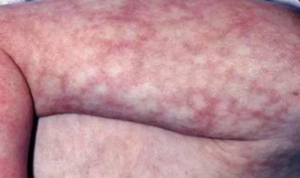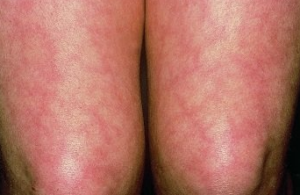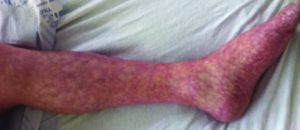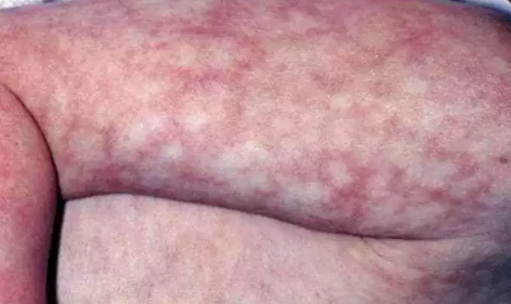What does having a mottled skin mean? Could mottled skin be the cause of the red patches appearing on your newborns arms, legs and trunk? Though it can equally affect the dark skin people, the condition is more visible in light skin people. In this discussion we shall tell you about the causes and how the condition appears. We shall also tell you why you could develop the condition before death.

Mottled skin also referred to as livedo reticularis is a common skin finding. It is caused by changes in the blood vessels found directly on the skin surface. Common causes will thus include fluctuation of body temperature, advanced age, coagulation, certain blood disorders, low platelets count and too much sun. For some people, the condition can also occur as an allergic reaction to the medication they are taking. A medical condition such as lupus and rheumatoid arthritis can also cause this kind of skin disorder.
Mottled Skin Definition – Meaning
Mottled skin literally means the skin is marked with spots or smears of color. The condition as said usually, usually appears as red patches on the trunk, arms, and legs. The red patches will then turn purple and dark brown over time.
The patches are more visible in light skin people but dark skinned people are equally affected. The signs of this condition are more apparent in cold environments. Though the condition can be embarrassing, there is no pain commonly associated with the condition.
Treatment for this condition will in most cases center on treating the underlying disorder causing the symptoms. Unless the underlying cause is reversed, there is no permanent treatment for the condition. Topical creams and lotion might work for the symptoms but the chances of flare up are very high.
Mottled Skin Causes
Here we shall discuss the possible causes of mottled skin. Below are some of the possible disease or condition found to affect more than a million people in the United States. This skin conditions are common and can affect anybody regardless of age, gender or skin color. The condition include but not limited to the following:
Lupus
Lupus refers to any of skin condition marked by inflammation of the skin. The most common form of these conditions is lupus vulgaris and lupus erythematosus. With lupus, the body immune system becomes hyperactive and start to attack normal, healthy body.
People with lupus will have symptoms such as inflammation, swelling and damage to joints, skin, kidney, blood, blood vessels and lung. When it attacks blood vessels underneath the skin it could result in mottled skin.
Rheumatoid arthritis
This is another form of an autoimmune disorder that can cause damage to joints. The symptoms of this condition can include fever, swollen and painful joints. The inflammation and thickening of joint muscles could result in mottling of the skin.
Vitiligo
Vitiligo is a skin condition in which skin pigments are lost from areas of the skin. The condition could result in white patches on skin with no clear cause.
Melanoma
Though not that common, melanoma is said to attack close to 200000 Americans every year. Melanoma is a malignant tumor associated with skin cancer. It develops from the pigments that contain cells known as melanocytes.
Cutaneous vasculitis
This is the inflammation of the blood vessels. It causes changes in the walls of these vessels. These changes include thickening, weakening, narrowing and scarring. When these changes occur on the vessels beneath the skin, it could lead to skin mottling.
Other possible causes include:
- Livedo reticularis
- Juvenile rheumatoid arthritis
- Low platelet count
- Fluctuation of body temperatures
- Advanced age
Mottled Skin When Cold
The signs and symptoms of mottled skin are more apparent during cold. Raynaud phenomenon (RP), a condition where some of the body’s blood vessels constrict in an exaggerated way in response to cold or emotional stress.
Normally, it is the blood vessels that supply’s the skin with nutrients, allow for tissue metabolism and works to provide an important balance of the body temperature. Specialized skin vessels constrict or narrow in response to cold. This reaction referred to as vasoconstriction, decreases the blood flow to the skin which help minimize heat loss. By so doing, the body is able to maintain its core or internal temperature.
The blood vessels supplying other parts of the body like the ear, nose, face, knees and nipples can also be affected. The skin in this areas and other parts of the body will thus become pale, or bluish I color after cold exposure. This phenomenon can also result in mottled skin on arms and legs of those affected.
The symptoms of this condition will clear on their own as the provoking factors are removed. These factors as discussed above will include stress and cold environments. When you warm yourself after getting out of cold, the discoloration will resolve within 20 minutes or so, and as the normal blood flow resume, the skin blushes or becomes pink.
Those with severe RP can at times experience a serious decrease in blood flow. The discoloration may fail to resolve even after the provoking factors have been removed. For these people even the normal flow of blood may fail to resolve. Severe RP can thus be characterized by pain and ulceration of the skin.
The condition can be prevented by doing the following:
- Avoiding cold exposure
- Keep your body especially hand warm, you could do these by placing them under warm water or in a warm place
- Avoid smoking as nicotine causes blood vessels to constrict
- Avoid medication that could cause vasoconstriction these would include medication such as decongestant
- Reduce stress by using relaxing techniques.
Mottled Skin Pictures, Images
We have provided some images of how mottled skin appears on arms and legs and other body parts. Remember the extent of spread will vary depending on the underlying cause of the mottling. The images provide are for illustration and cannot substitute a professional heath diagnosis.


It is important to have a dermatologist diagnose the symptoms to establish what the underlying condition causing the condition is. This way, you will be able to get rid of the mottling by treating the underlying condition and not the symptoms.
Mottled Skin in Newborns, Toddlers or Baby
Mottled skin in newborns, toddlers and baby can cause a lot of anxiety to the parents. Though the mottling is harmless and will disappear as the child grow, this is just not good news for the parents. As discussed above, any change in the blood vessels can lead to mottled skin or irregular spots on skin that turns greenish.
As said earlier, the mottling will occur at any age, newborns are no exception. Though it may not be accompanied by pain, it is a clear indication of some systemic condition that needs medical attention. In newborns, the mottling can occur on any part of the skin. Certain parts like the lips, genitals and nose are sometimes spared.
Most pediatricians say the mottling in babies is due to the underdeveloped vascular structure or the circulatory system. The other possible cause of the mottling is the over exposure to sun for long hours. This is a common cause of the mottling for both the adults and toddlers. Skin mottling in itself is a symptom of an underlying condition. Instead of trying to treat the symptoms, it is prudent to have a pediatrician diagnose you child to get to the root cause of the visible symptoms.
The patches will be easily visible in kids with fair skin but that is not to say that those with dark skin are spared. The patches will fast appear as red them they will turn to purple or dark brown as time goes by. The condition is painless so unless you as a parent you are keen enough to notice the patches, your kid may not hint to their existence.
The best way to treat the mottling is to treat the underlying condition causing the mottling. For external causes that result in the mottling, the symptoms can be managed at home different way can also be carried out to prevent the mottling, like avoiding exposure to sun ray and extreme cold environments.
Make sure to apply your kid with some sunscreen if you have to be exposed to sun. Wearing protective clothing is also important as this protects the direct contact between the sun and the rays. Depending on the severity of the mottling, your child’s pediatrician may prescribe certain creams and lotion for local application.
Protective cloth and other gear can also help keep your kid warm and avoid vasocontraction. The same can be achieved by covering your kid in blanket and warm-ups, all this will help protect from cold temperatures. If after doing all this nothing seem to change seek medical attention.
Mottled Skin on Legs or Feet
Legs or feet are the most common part of the body that mottled skin appears. As we have seen by now, mottled skin will appear as red patches which turn purple or dark brown over time. These signs will be more noticeable in cold environments.
This skin condition can appear on any body part of anybody regardless of age, skin color or gender. The main cause of the mottling is change in skin vessel that lay underneath the skin surface. Other causes as described above will include fluctuation of body and environmental temperature, certain blood disorders, medical condition such as lupus and low platelet count.
Though painless the condition can be very embarrassing. To treat the condition, you need to first have a dermatologist or any professional health care provider diagnose the condition to establish the actual cause of the mottling. When this is done, the treatment will not only center on treating the symptoms but also treating the underlying cause of the symptoms.
For mild symptoms of mottling, your doctor may prescribe topical creams and lotion. This is however not a permanent solution for the condition. Derm Net NZ warns that there is no permanent solution for the mottling unless the underlying cause is reversed. If treatment is not undertaken in time, the blood vessel underneath the skin may become more dilated over time. This allows more blood to pool under the skin surface. This could cause the mottling to become permanent in some cases.
Mottled Skin on Arm
Not covering your arms when in cold or when o direct exposure to direct sun for long could result in the mottling of the skin on arms. Some to the mottling on legs, the skin will appear as red patches. Mottling on arms is often characterized by lacy or net-like patches.
Mottling on arms is common in old people but can also affect children and toddlers due to fluctuation of body temperature. In adults, the mottling is common to those who smoke or use other chemical products that can cause coagulation. Nicotine is said to cause blood vessel to constrict, this will intern reduce normal flow of blood to the skin which in turn causes mottling on skin.
There is no permanent solution to the mottling unless the underlying cause of the condition is treated. Avoid cold environments by wearing protective clothing like hand gloves or long sleeves especially for children. Adults to should cut on smoking and avoid taking beverages with lots of nicotine. Direct exposure to sun should be minimized, make sure to apply some sunscreen before you go out basking. See your dermatologist if the mottling lasts for more than a week or two.
Mottled Skin before Death or End of Life
As we grow old certain changes become irresistible and unavoidable. Your blood pressure gradually goes down and the heart rates gets faster but weaker. Different body parts like your fingers, earlobe, lips and nail beds may appear bluish or light gray. This and many other changes are common signs and symptoms that you are nearing death.
Decreased blood perfusion characterized by mottled and discolored skin. Mottling and cyanosis of upper extremities appear to indicate impending death compared to when it appear on lower extremities. As said these changes are irresistible, you cannot run away from them.
Interventions like providing good skin care or applying body creams and lotion can help manage some symptoms. Make sure to apply some sunscreen before you go basking in the sun, wearing protective clothes can also help keep your body warms. The next thing is to have regular checkups to your health care to make sure you are disease free. Maintain a stress-free life by practicing stress-relieving strategies like yoga.
Mottled Skin before Death Pictures
During old age and when nearing death, the following images illustrates how mottled skin appear like. Seek immediate medical attention to treat the underlying skin condition.

Mottled Skin Rash
With mottled skin rash, you will notice splotchy looking rash appearing on your body or those near you. The rash will appear as bluish-red common after exposure to cold. This condition is caused by a condition known as livedo reticularis
Livedo reticularis is a vascular rash that can appear anywhere on your body. It is, however, common on trunk, legs and arms. The condition occurs when there is contraction or narrowing of the blood vessels on underneath the surface of the skin. This is what creates the mottled lace-like rash.
He rash is common in young and middle-aged women. It is common during winter as it acts like a response to cold. This is the most common form livedo reticularis. The condition is often temporary but could become permanent causing numbness or tingling. Other forms of this condition will include:
- Cutis mar Morata
- Sneddon’s syndrome
- Antiphospholipid syndrome
- The condition can also be caused by other underlying medical condition.
Mottled Skin Discoloration
In itself, mottled skin will appear as patches or spots or smears of color. When these patches or irregular skin color are caused by the underlying blood vessels, then that is when we say you have a mottled skin. Dyschromia is the medical term used to describe these form of skin discoloration.
For most people the irregular or patchy discoloration of the skin can be caused by some of the following conditions:
- Certain change in the levels of melanin. Melanin is the substance that gives the skin the dark coloring. This can be triggered by heat, injury, fungal infection and exposure to heavy metals.
- Overgrowth of bacteria and other microorganism on the skin can also result in these irregular changes.
- Vascular changes (vasodilation and vasoconstriction) can also cause skin mottling as a response to change in environmental temperatures
Red Mottled Skin on Back
Red mottled skin on back common in both children and adults can be caused by exposure to sun ultraviolet rays. Some medicine and drugs can increase skin color or pigmentation. This increase pigment production is known as hyperpigmentation, it could result from certain rashes as well as overexposure to direct sun rays.
The opposite is hypopigmentation, this means a decrease in production of melanin pigments. On your back, the mottling can also be a symptom of an underlying condition such as acne, melanoma, vitiligo and other skin conditions.
Seek the professional attention of a dermatologist who will prescribe the appropriate treatment depending on other visible symptoms shown. Treating the underlying cause of the red mottled skin the best way to get rid of the discoloration appearing on your back.
Mottled Skin Treatment
Treating mottled skin depends on what the underlying cause of the mottling is. Treating these underlying causes if the most effective way to treat and get rid of the mottling. Depending on how severe the mottling and patchy the skin is, treatment will include the following three ways:
- Chemical peels where your skin is soaked in chemical to reduce get rid of the discoloration.
- Photo rejuvenation can also be done to remedy the mottling
- Laser resurfacing can also be used to for severe cases of mottling.
How to Get Rid Of Mottled Skin – Video
Sources and reference:
- https://www.reference.com/health/mottled-skin-indicate-e6f6b62cb3149e54
- http://www.rightdiagnosis.com/sym/mottled_skin.htm
- http://www.tandurust.com/skincare/mottled-skin-causes-treatment.html
- http://www.healthmeds.org/skin/mottled-skin/
- http://www.wisegeekhealth.com/what-is-the-treatment-for-mottled-skin.htm
- https://www.epainassist.com/skin/mottled-skin




